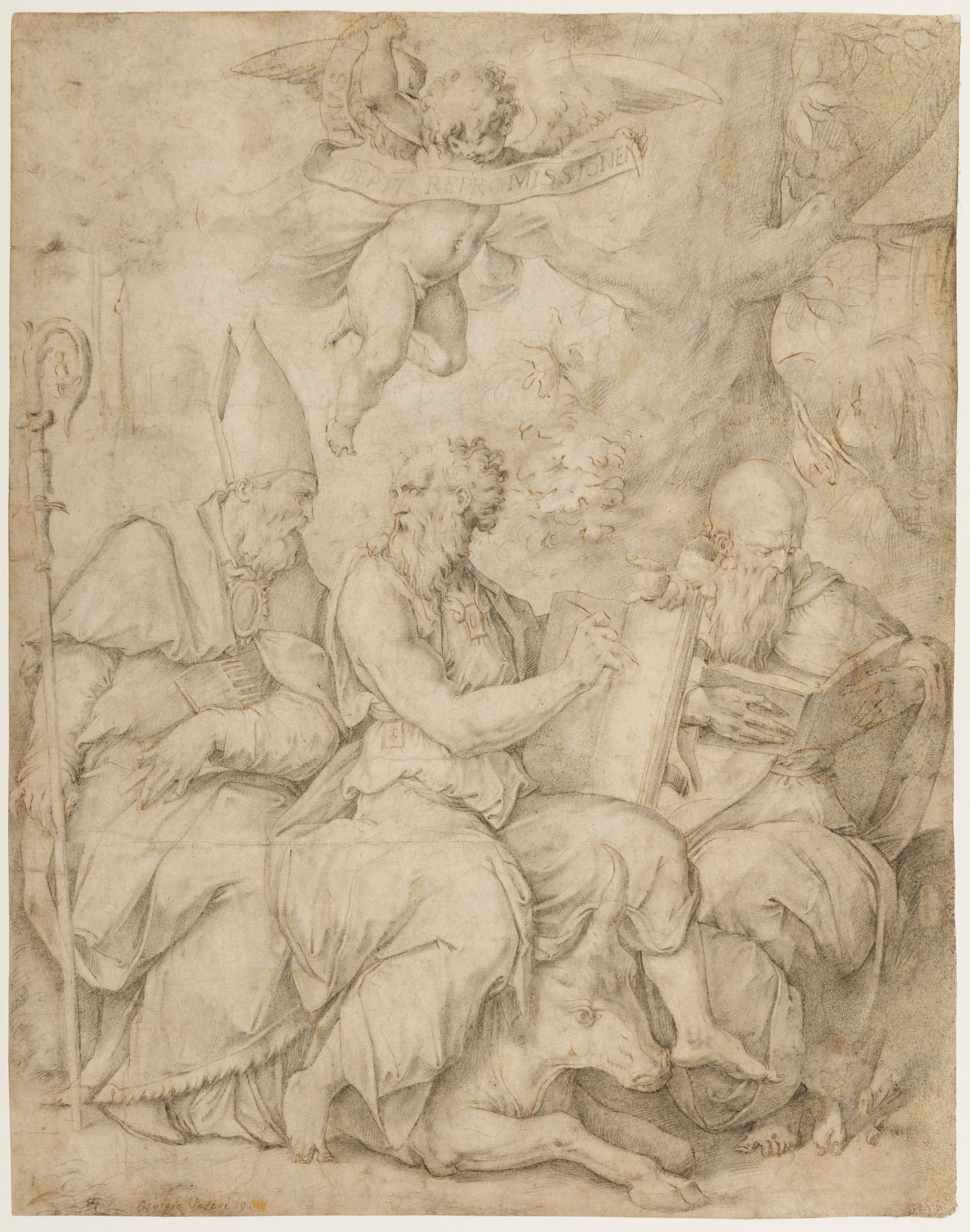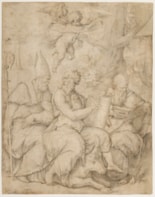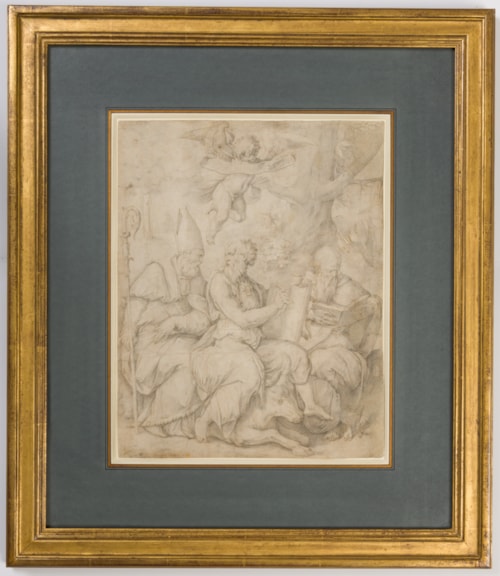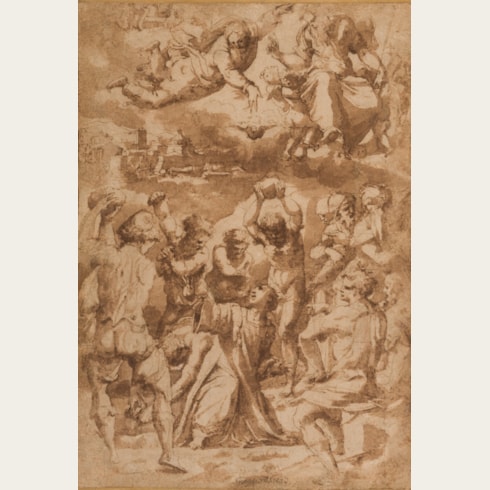Giorgio VASARI
(Arezzo 1511 - Florence 1574)
Saints Blaise, Luke and Dominic (or Anthony Abbot?) Seated in a Landscape
Sold
Black chalk, pen and brown ink and grey wash.
Inscribed SUNT ADEPTI REPROMISSIONEN on the scroll held by the putto above.
Further inscribed Giorgio Vasari 9 at the lower left.
Large made up areas at the upper right corner, centre right edge and lower right edge and corner.
340 x 268 mm. (13 3/8 x 10 1/2 in.)
ACQUIRED BY THE ASHMOLEAN MUSEUM, OXFORD.
Inscribed SUNT ADEPTI REPROMISSIONEN on the scroll held by the putto above.
Further inscribed Giorgio Vasari 9 at the lower left.
Large made up areas at the upper right corner, centre right edge and lower right edge and corner.
340 x 268 mm. (13 3/8 x 10 1/2 in.)
ACQUIRED BY THE ASHMOLEAN MUSEUM, OXFORD.
Datable to the middle of the 1540s, this fine drawing by Giorgio Vasari was in all likelihood a design for an altarpiece, although no related painting survives. As the Vasari scholar Florian Härb has noted, the figures in the present sheet are akin to those in the organ shutters painted by Vasari between 1545 and 1546 for the cathedral of San Gennaro in Naples. Indeed, the putto holding a scroll at the top of this drawing is repeated, with few differences, in the right-hand inner panel of the San Gennaro organ shutters. As Härb further points out, the present sheet may be likened to a pair of stylistically comparable drawings by Vasari of A Prophet (or Simeon?) and The Prophetess Anna, each with similar putti holding scrolls and also datable to c.1545, in a private collection.
This drawing must have been highly regarded in Vasari’s day, as copies of it by two of his artistic contemporaries and followers are known. A variant of this composition, lacking the putto above and with other significant differences, particularly in the left-hand figure of Saint Blaise, is in the collection of the National Galleries of Scotland in Edinburgh, and has been attributed to Vasari’s pupil and assistant Cristofano Gherardi, known as Il Doceno (1508-1556). Another copy of this composition, drawn in pen and brown ink and wash, is found on the verso of a double-sided drawing by Giovanni Battista Naldini (1535-1591) in the Ashmolean Museum in Oxford.
The present sheet was one of at least two sheets by Vasari in the collection of William Buller Fagg (1914-1992), an anthropologist, ethnographer and art historian who had a long career at the British Museum.
This drawing must have been highly regarded in Vasari’s day, as copies of it by two of his artistic contemporaries and followers are known. A variant of this composition, lacking the putto above and with other significant differences, particularly in the left-hand figure of Saint Blaise, is in the collection of the National Galleries of Scotland in Edinburgh, and has been attributed to Vasari’s pupil and assistant Cristofano Gherardi, known as Il Doceno (1508-1556). Another copy of this composition, drawn in pen and brown ink and wash, is found on the verso of a double-sided drawing by Giovanni Battista Naldini (1535-1591) in the Ashmolean Museum in Oxford.
The present sheet was one of at least two sheets by Vasari in the collection of William Buller Fagg (1914-1992), an anthropologist, ethnographer and art historian who had a long career at the British Museum.
Best known today as the author of the magisterial Vite de’ piu eccelenti pittori, scultori ed archittetori, first published in 1550 and again in an expanded edition in 1568, Giorgio Vasari was a painter, architect, art historian and collector. A native of Arezzo, he settled in Florence in 1524, studying there with Andrea del Sarto, Baccio Bandinelli and Rosso Fiorentino before undertaking a trip to Rome in 1532. Among his major commissions were the fresco decoration of the salone of the Palazzo della Cancelleria in Rome, painted in 1546 for Cardinal Alessandro Farnese, and the extensive decoration of the various rooms of the Palazzo Vecchio in Florence, a massive project planned and designed by Vasari and completed by him and a team of artists under his direction in 1572. In the 1560s he and his workshop also undertook the painting of altarpieces for several Florentine churches, notably in Santa Croce and Santa Maria Novella. Vasari was one of the founders of the Accademia del Disegno in Florence, established under the patronage of Cosimo I de’Medici in 1563. Apart from Florence, Rome and Arezzo, he worked in Bologna, Cortona, Naples, Ravenna, Venice and elsewhere, and his patrons included three popes, two Grand Dukes of Tuscany and numerous wealthy noblemen, as well as many religious and secular institutions. Also active as an architect, Vasari was involved in a number of renovations of medieval churches in the 1560s, including Santa Maria Novella and Santa Croce in Florence and Santa Maria delle Pieve and the Badia in Arezzo. He also designed the loggia of the Palazzo degli Uffizi and the Vasari Corridor, leading from the Uffizi to the Palazzo Pitti, which was completed in 1565. Near the end of his life, he and his assistants painted a cycle of frescoes in the rooms of his house in Borgo Santa Croce in Florence, and he began work on an enormous fresco of The Last Judgement on the cupola of the nearby Duomo; a project completed after his death by Federico Zuccaro.
Vasari was a gifted and prolific draughtsman, and around five hundred drawings by him survive today, the vast majority held in two public collections, namely the Louvre in Paris and the Uffizi in Florence. (This may represent only a part of his total output of drawings, however, since relatively few sheets survive from the artist’s early career, with one such loss being a putative album of anatomical studies.) He generally worked in either pen and ink and wash or black or red chalk, sometimes on coloured paper, and a particular penchant for blue paper is evident in his work following a stay in Venice in the 1540s. Vasari was also an avid collector of drawings by other artists, building up a substantial collection that he carefully assembled into albums, which he referred to as his Libro de’ disegni.
Vasari was a gifted and prolific draughtsman, and around five hundred drawings by him survive today, the vast majority held in two public collections, namely the Louvre in Paris and the Uffizi in Florence. (This may represent only a part of his total output of drawings, however, since relatively few sheets survive from the artist’s early career, with one such loss being a putative album of anatomical studies.) He generally worked in either pen and ink and wash or black or red chalk, sometimes on coloured paper, and a particular penchant for blue paper is evident in his work following a stay in Venice in the 1540s. Vasari was also an avid collector of drawings by other artists, building up a substantial collection that he carefully assembled into albums, which he referred to as his Libro de’ disegni.
Provenance
William Buller Fagg CMG, London
His posthumous sale, London, Christie’s, 20 April 1993, lot 12
Yvonne Tan Bunzl, London, in 1994
Anonymous sale, Paris, Christie’s, 27 November 2002, lot 29
Private collection, Massachusetts.
His posthumous sale, London, Christie’s, 20 April 1993, lot 12
Yvonne Tan Bunzl, London, in 1994
Anonymous sale, Paris, Christie’s, 27 November 2002, lot 29
Private collection, Massachusetts.
Literature
Florian Härb, Giorgio Vasari (1511-1574). Die Zeichnungen, unpublished Ph.D dissertation, University of Vienna, 1994, no.100; Mario di Giampaolo, ed., Disegno italiano antico: Artisti e opere dal Quattrocento al Settecento, Milan, 1994, illustrated p.220; London, Yvonne Tan Bunzl, Master Drawings, 1994, unpaginated, no.4; Florian Härb, The Drawings of Giorgio Vasari (1511-1574), Rome, 2015, p.251, no.108 (as location unknown), and p.250, under no.107; Anna Bisceglia, ‘Spazio ecclesiale e pale controriformate in Santa Maria Novella’, in Riccardo Spinelli, ed., Santa Maria Novella: La Basilica e il Convento. 3. Dalla ristruzione vasariana e granducale ad oggi, Florence, 2017, p.78, fig.2.






